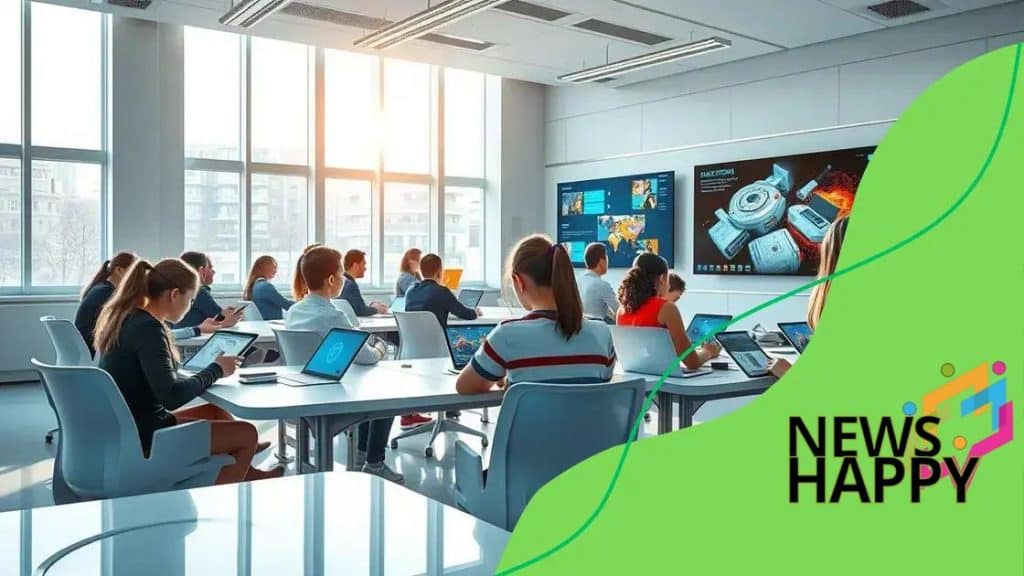How digital classrooms are evolving with new technology

Anúncios
The future of education technology is characterized by the integration of artificial intelligence, virtual reality, and blended learning, enhancing engagement, accessibility, and personalized learning experiences for students.
How digital classrooms are evolving with new technology is reshaping the educational landscape. Imagine a learning environment where technology seamlessly integrates with teaching methods, making learning more engaging. Ready to explore how this affects students and teachers alike?
Anúncios
The role of technology in modern classrooms
Technology plays a vital role in modern classrooms, enhancing both teaching and learning experiences. By integrating various tools, educators can create dynamic environments that cater to diverse learning styles.
Interactive Learning Environments
Classrooms equipped with interactive whiteboards and tablets encourage student participation. These tools make lessons more engaging, enabling students to interact directly with content.
Access to Educational Resources
With online resources, students can easily access a wealth of information. This accessibility fosters independent learning and research skills, crucial for academic success today. For example:
Anúncios
- Online libraries and databases offer vast collections of materials.
- Educational apps provide interactive lessons for various subjects.
- Webinars and virtual lectures connect students with experts globally.
Moreover, technology enables personalized learning. Teachers can tailor lessons to meet individual needs, ensuring that every student can learn at their own pace. Adaptive learning platforms analyze student performance, providing targeted resources for improvement.
Collaboration also benefits greatly from technology. Tools like Google Classroom allow students to work together on projects from different locations. This collaborative approach teaches essential skills like teamwork and communication.
Preparing for the Future
Ultimately, integrating technology in classrooms prepares students for the future. As technology continues to evolve, so do the skills needed to succeed in the workforce. Learning how to use digital tools becomes essential.
In summary, the role of technology in modern classrooms is multifaceted. It enhances engagement, boosts accessibility, personalizes learning, and fosters collaboration. By embracing these advancements, educators set their students on a path to success.
Benefits of digital learning tools
Digital learning tools offer numerous benefits that enhance student engagement and understanding. With these tools, learning becomes more interactive and enjoyable for students of all ages.
Increased Accessibility
One major advantage of digital learning tools is their accessibility. Students can access resources anytime and anywhere. This flexibility allows them to study at their own pace and review materials as needed.
Enhanced Engagement
With the use of multimedia content such as videos, podcasts, and interactive quizzes, digital tools create a more engaging learning environment. These formats can hold students’ attention better than traditional lectures.
- Interactive simulations help students visualize complex concepts.
- Gamified learning platforms make studying fun and competitive.
- Discussion forums encourage collaboration and peer learning.
Moreover, digital learning tools promote personalized learning experiences. They adapt to students’ learning speeds, ensuring that each individual can progress according to their capability. This targeted approach helps in addressing learning gaps.
Teachers can also track student progress more efficiently using digital tools. Real-time data allows them to identify areas where students struggle and adjust their teaching methods accordingly.
Cost-Effectiveness
Additionally, many digital learning resources are cost-effective. Schools can save money on textbooks and printed materials by utilizing free or low-cost online resources.
In summary, the benefits of digital learning tools are significant and far-reaching. They increase accessibility, enhance engagement, provide personalized experiences, and can reduce costs for educational institutions.
Challenges faced by educators today

Today, educators encounter various challenges that impact their ability to teach effectively. These challenges can disrupt the flow of learning and hinder student success.
Adapting to Technology
As classrooms become more digital, teachers must adapt their teaching methods to incorporate new technologies. This can be overwhelming, especially for those who are not tech-savvy. Digital tools can change traditional teaching practices, requiring educators to learn and implement new strategies.
Time Management
Many teachers struggle with time management. Balancing lesson planning, grading, and administrative tasks can be a daunting task. With limited hours in the day, teachers often find themselves stretched thin.
- Managing time effectively can lead to higher quality lessons.
- Prioritizing student needs is essential but challenging.
- Finding time for personal and professional development is often difficult.
Additionally, large class sizes contribute to the challenges educators face. When teachers have too many students, giving individual attention becomes difficult. This can lead to students feeling overlooked and disengaged.
Furthermore, educators must address the diverse needs of their students, including different learning styles and backgrounds. Tailoring instruction to meet these varying needs requires significant effort and resources, which may not always be available.
Emotional and Mental Strain
The emotional and mental strain on teachers can also be significant. The pressure to improve student performance while managing classroom dynamics can lead to burnout. Teachers often work after hours, taking work home, which is not always sustainable.
Overall, while educators are dedicated to their students, the challenges they face today can be considerable. Addressing these hurdles is essential to fostering a productive learning environment.
Innovative practices in digital teaching
Innovative practices in digital teaching are transforming how educators engage with students. By leveraging technology, teachers can create a more interactive and effective learning environment.
Flipped Classroom Model
One popular approach is the flipped classroom model. In this setup, students learn new content at home through online videos and readings, while class time is used for discussions and hands-on activities. This method allows students to grasp concepts at their own pace, enhancing understanding.
Gamification of Learning
Another innovative practice is gamification, where elements of game design are incorporated into learning activities. This approach makes lessons more engaging and motivating. For instance:
- Points and badges reward students for completing tasks.
- Quests and challenges create a sense of adventure in learning.
- Leaderboards encourage healthy competition among peers.
Additionally, project-based learning is gaining traction in digital classrooms. This method encourages students to work on real-world projects, fostering critical thinking and collaboration. By solving real problems, students gain valuable skills and knowledge.
Integrating technology also allows teachers to provide immediate feedback. With tools like learning management systems, educators can track student progress in real time. This capability helps to identify areas needing improvement promptly.
Collaborative Learning Platforms
Utilizing collaborative platforms like Google Workspace and Microsoft Teams enables students to work together, regardless of location. These platforms support group projects and discussions, making learning more interactive.
By adopting innovative practices in digital teaching, educators can enhance engagement, improve learning outcomes, and prepare students for a technology-driven world. The integration of these methods emphasizes the importance of adaptability in today’s educational landscape.
The future of education technology
The future of education technology holds exciting possibilities that can transform the learning experience. With rapid advancements in technology, classrooms are becoming more interactive and accessible.
Artificial Intelligence Integration
One key trend is the integration of artificial intelligence (AI) in education. AI can provide personalized learning experiences by adapting to each student’s pace. For example, AI-driven platforms can analyze student performance and tailor resources to help them improve in specific areas.
Virtual and Augmented Reality
Virtual and augmented reality (VR and AR) technologies are also set to revolutionize learning. These tools can create immersive experiences that transport students to different environments or historical periods. Such simulations can enhance understanding and retention of complex concepts.
- Students can explore outer space or ancient civilizations right from their classrooms.
- Hands-on learning through VR can deepen engagement.
- AR can overlay information on real-world objects, making learning more relevant.
Another future direction is the rise of blended learning models that combine online resources with traditional face-to-face instruction. This approach allows flexibility while maintaining essential personal interactions. Teachers can use digital resources to supplement and enhance their lessons.
Moreover, cloud technologies will play a significant role in the future of education. Storing educational materials and assignments in the cloud makes them easily accessible from anywhere. This accessibility supports continuous learning beyond the classroom and fosters collaboration among students and teachers.
Focus on Lifelong Learning
The future of education technology also emphasizes lifelong learning. As the job market evolves, individuals will need to reskill and upskill continually. Online platforms enable people of all ages to take courses and acquire new skills irrespective of traditional school settings.
In summary, the future of education technology is bright and filled with potential. With innovations like AI, VR/AR, blended learning, and cloud solutions, the way we teach and learn will continue to evolve, making education more accessible and engaging for everyone.
FAQ – Frequently Asked Questions about the Future of Education Technology
What is the role of artificial intelligence in education?
Artificial intelligence helps personalize learning experiences by adapting to each student’s pace and providing tailored resources to improve understanding.
How does gamification enhance learning?
Gamification makes education more engaging by incorporating game elements like points, badges, and challenges, motivating students to participate actively.
What benefits do virtual and augmented reality offer in education?
VR and AR create immersive learning experiences that allow students to explore environments and concepts in a hands-on way, enhancing understanding.
Why is blended learning important?
Blended learning combines online resources with traditional face-to-face instruction, offering flexibility while maintaining essential personal interactions.





